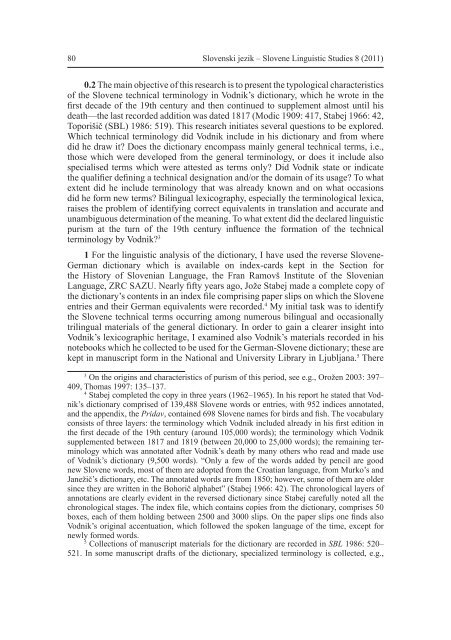Slovenski jezik Slovene Linguistic Studies - KU ScholarWorks
Slovenski jezik Slovene Linguistic Studies - KU ScholarWorks
Slovenski jezik Slovene Linguistic Studies - KU ScholarWorks
You also want an ePaper? Increase the reach of your titles
YUMPU automatically turns print PDFs into web optimized ePapers that Google loves.
80 <strong>Slovenski</strong> <strong>jezik</strong> – <strong>Slovene</strong> <strong>Linguistic</strong> <strong>Studies</strong> 8 (2011)<br />
0.2 The main objective of this research is to present the typological characteristics<br />
of the <strong>Slovene</strong> technical terminology in Vodnik’s dictionary, which he wrote in the<br />
first decade of the 19th century and then continued to supplement almost until his<br />
death—the last recorded addition was dated 1817 (Modic 1909: 417, Stabej 1966: 42,<br />
Toporišič (SBL) 1986: 519). This research initiates several questions to be explored.<br />
Which technical terminology did Vodnik include in his dictionary and from where<br />
did he draw it? Does the dictionary encompass mainly general technical terms, i.e.,<br />
those which were developed from the general terminology, or does it include also<br />
specialised terms which were attested as terms only? Did Vodnik state or indicate<br />
the qualifier defining a technical designation and/or the domain of its usage? To what<br />
extent did he include terminology that was already known and on what occasions<br />
did he form new terms? Bilingual lexicography, especially the terminological lexica,<br />
raises the problem of identifying correct equivalents in translation and accurate and<br />
unambiguous determination of the meaning. To what extent did the declared linguistic<br />
purism at the turn of the 19th century influence the formation of the technical<br />
terminology by Vodnik? 3<br />
1 For the linguistic analysis of the dictionary, I have used the reverse <strong>Slovene</strong>-<br />
German dictionary which is available on index-cards kept in the Section for<br />
the History of Slovenian Language, the Fran Ramovš Institute of the Slovenian<br />
Language, ZRC SAZU. Nearly fifty years ago, Jože Stabej made a complete copy of<br />
the dictionary’s contents in an index file comprising paper slips on which the <strong>Slovene</strong><br />
entries and their German equivalents were recorded. 4 My initial task was to identify<br />
the <strong>Slovene</strong> technical terms occurring among numerous bilingual and occasionally<br />
trilingual materials of the general dictionary. In order to gain a clearer insight into<br />
Vodnik’s lexicographic heritage, I examined also Vodnik’s materials recorded in his<br />
notebooks which he collected to be used for the German-<strong>Slovene</strong> dictionary; these are<br />
kept in manuscript form in the National and University Library in Ljubljana. 5 There<br />
3<br />
On the origins and characteristics of purism of this period, see e.g., Orožen 2003: 397–<br />
409, Thomas 1997: 135–137.<br />
4<br />
Stabej completed the copy in three years (1962–1965). In his report he stated that Vodnik’s<br />
dictionary comprised of 139,488 <strong>Slovene</strong> words or entries, with 952 indices annotated,<br />
and the appendix, the Pridav, contained 698 <strong>Slovene</strong> names for birds and fish. The vocabulary<br />
consists of three layers: the terminology which Vodnik included already in his first edition in<br />
the first decade of the 19th century (around 105,000 words); the terminology which Vodnik<br />
supplemented between 1817 and 1819 (between 20,000 to 25,000 words); the remaining terminology<br />
which was annotated after Vodnik’s death by many others who read and made use<br />
of Vodnik’s dictionary (9,500 words). “Only a few of the words added by pencil are good<br />
new <strong>Slovene</strong> words, most of them are adopted from the Croatian language, from Murko’s and<br />
Janežič’s dictionary, etc. The annotated words are from 1850; however, some of them are older<br />
since they are written in the Bohorič alphabet” (Stabej 1966: 42). The chronological layers of<br />
annotations are clearly evident in the reversed dictionary since Stabej carefully noted all the<br />
chronological stages. The index file, which contains copies from the dictionary, comprises 50<br />
boxes, each of them holding between 2500 and 3000 slips. On the paper slips one finds also<br />
Vodnik’s original accentuation, which followed the spoken language of the time, except for<br />
newly formed words.<br />
5<br />
Collections of manuscript materials for the dictionary are recorded in SBL 1986: 520–<br />
521. In some manuscript drafts of the dictionary, specialized terminology is collected, e.g.,
















